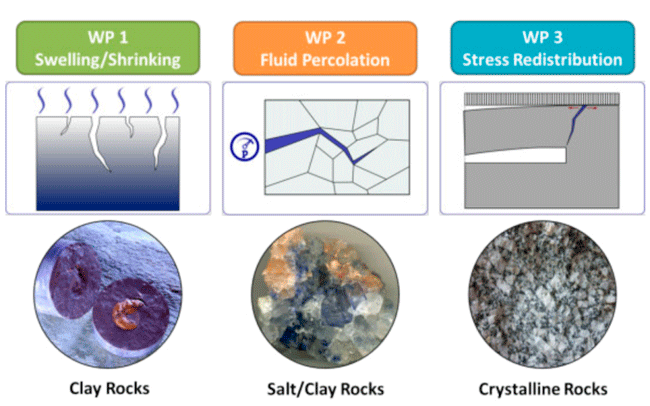GeomInt

Project title: Geomechanische Integrität von Wirts- und Barrieregesteinen – Experiment, Modellierung und Analyse von Diskontinuitäten – Teilprojekt: Modellierung von Wegsamkeiten – Numerische Simulation komplexer Prozesse und Datenmanagement mit OpenGeoSys
(Project title – English translation: Geomechanical integrity of host and barrier rocks – Experiments, modelling and analysis of discontinuities – Subproject: Modelling of potential fluid paths – Numerical simulation of complex processes and data management with OpenGeoSys)
Short project description:
Interventions in the geological subsurface, such as the extraction and storage of energy or the safe storage of toxic and radioactive waste, requires careful geoscientific investigations and prognostic studies in the context of different disciplines in order to avoid adverse effects on the environment. In particular, deformation processes and physicochemical alterations can lead to a profound damage to rocks and thus adversely affect the integrity of geological barriers. The various micro- and macro-mechanical structures (fissures, cracks, fractures, etc.) weaken the rock from a mechanical point of view and can lead to unintentional pathways for the migration of pollutants. They can be generalized as discontinuities. Their development is usually inadequately understood and cannot be adequately modelled with currently available simulation systems.
The aim of the collaborative project is to provide a realistic, experimental-numerical analysis of the formation and development of discontinuities in geological barriers using the example of salt, clay and crystalline rocks. The focus is on typical processes that lead to the development of specific discontinuities. These include swelling and shrinkage processes, pressure-driven percolation and stress redistributions.
At the UFZ, numerical methods for the analysis of thermal-hydraulic-mechanical processes in underground rocks will be developed and implemented in the open-source software OpenGeoSys, taking into account structural discontinuities. As rock types, salt, clay and crystalline rocks will be considered. The numerical analysis is carried out with different approaches such as the Extended Finite Element Method and the Phase Field Method. While laboratory experiments by network partners serve to demonstrate the basic suitability of the methods developed, in-situ experiments form the basis for the definition and parameterisation of practice-relevant test examples as well as typical numerical benchmarks for model and software evaluation. Scenario simulations are focused on the generation and development of discontinuities. The project results form the basis for the preparation or updating of guidelines.
Project duration: 07/17 – 06/20
Funding organisation: BMBF

Project partners:
- Federal Institute for Geosciences and Natural Resource (BGR)
- Helmholtz Centre for Environmental Research – UFZ – coordinator
- Institute of Geomechanics GmbH Leipzig IfG
- Kiel University Christian Albrechts Universität zu Kiel (CAU)
- Technische Universität Bergakademie Freiberg
- University of Stuttgart
The research for this project is being conducted in close cooperation with the Chair of Soil Mechanics and Foundation Engineering at the TU Bergakademie Freiberg.
At the Department of Environmental Informatics, research for this project is being conducted at the workgroup Computational Energy Systems.
Project website: https://www.ufz.de/geomint
This research is also part of the OpenGeoSys initiative (http://www.opengeosys.org/).
